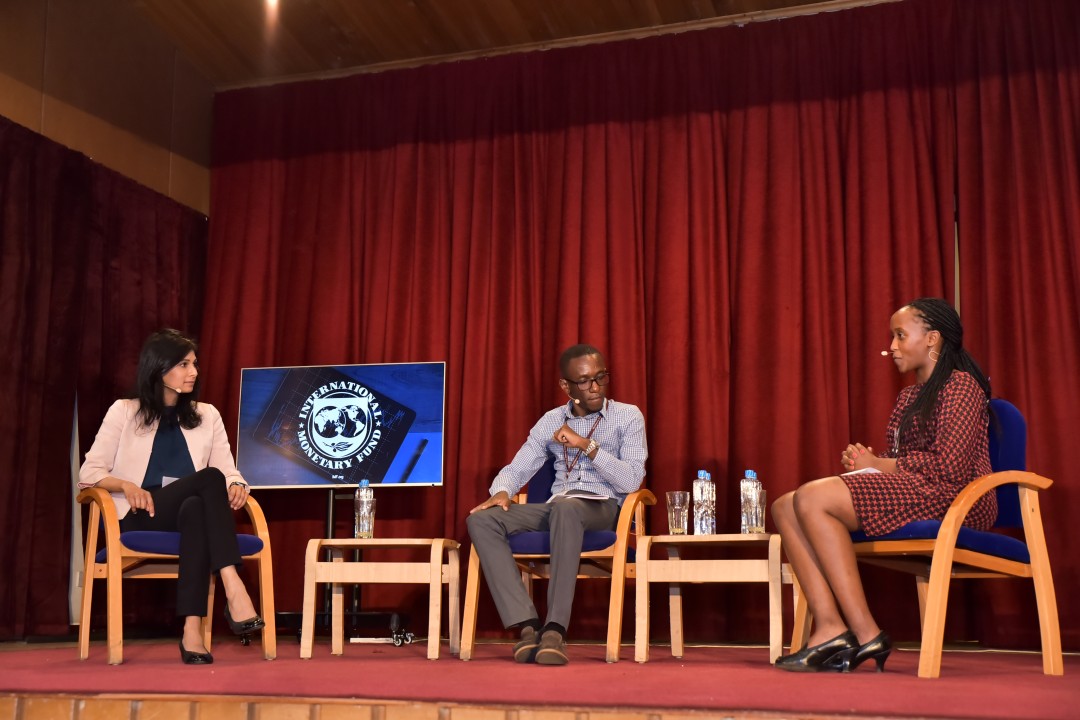In a dynamic approach, the conversation was led by two students of the Masters programs at Strathmore Business School, Terry Gakuru and Reuben Chahilu. Key insights from the conversation:
1. 2020 Projections
Whereas the IMF had projected that global growth would increase modestly from 2.9 percent in 2019 to 3.3 percent in 2020 and 3.4 percent in 2021, coronavirus has thrown off these projections. Economic recovery driven by emerging economies is still factored in, as growth in advanced economies slows to a sub 2%. The announcement of a US-China Phase I trade deal and a lower likelihood of a no-deal Brexit reduced downside risks. An updated outlook will be released in April factoring in the changes, speaking to how fiscal policy can play a role for the next global approach.
2. Vulnerability factors for Africa
As global commodity prices collapsed, Africa has been on the receiving end of economic uncertainty. Domestic challenges such as unsustainable levels of expenditure and rising public debt also place several of her states in a vulnerable position. Countries are increasingly taking up loans with longer periods of repayment, with Ghana issuing sub-Saharan Africa’s longest-ever Eurobond with an average life of 40 years. The challenge being that countries’ expenditure ends up wasted, in that it is not well targeted.
3. Multilateral institutions rising to global challenges
The IMF projects the need to do reparative action in advance of possible long-term effects of corona virus. Furthermore, multilateral institutions are becoming of need more significantly as climate disaster response comes in, for instance where the GDP of states is threatened with being inadvertently wiped out by a disaster. According to the United Nations Environment Programme, the annual costs of adapting to climate change in developing countries may range from $140 billion to $300 billion by 2030, or two to three times the currently available funding. IMF economists are advancing a push for investment in resilience which may cut the costs of post disaster intervention by at least half.
4. Opportunities within climate change
Both climate mitigation and adaptation promise opportunities for states, for instance through development of mobile technologies for farmers to inform them of changing rainfall patterns and help in planning. States are increasingly cross insuring themselves, noting different countries experience different climate situations at different times and can therefore periodically expand to accommodate the needs met by other states.
5. On employment
We need to reskill our populations to match relevance in the workplace. Modern approaches to the informal sector are needed to increase productivity where it is notably low. As the formal sector grows you more, policies are geared towards encouraging the formal sector.
Fireside chat:
- Would IMF consider pioneering an alternative approach, as opposed to GDP as an indicator of growth?
GDP factors in several variables. Furthermore, surveys of happiness are often correlated with GDP.
- To what extent does monetary policy distort asset prices?
Asset pricing is seen to rise as a result of low interest rates. In 2019 49[1] countries had cut interest rates and the net effect has helped the global economy.
- Is there a case for changing the global reserve currencies?
Unlikely. As a result of the longer period they have been in use there is more trust in these institutions. More recent valuations such as Bitcoins and Stablecoins are more speculative forms of investment. They however pose a potential for greater financial inclusion.
- Why doesn’t GDP growth correspond with what people perceive on the ground e.g. unemployment?
In Kenya whereas the manufacturing sector and agricultural sector are in relative decline, growth is coming from public investment and public consumption. Expand the focus beyond employment/unemployment and look at the productivity within that employment.
Written by Diana Owuor, a budding investment strategist who operates at the intersection of international trade and development.
